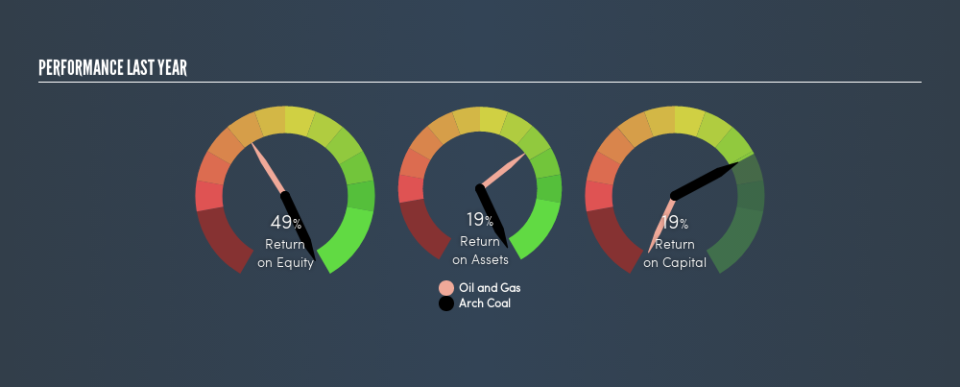Why We Like Arch Coal, Inc.’s (NYSE:ARCH) 19% Return On Capital Employed

Today we'll evaluate Arch Coal, Inc. (NYSE:ARCH) to determine whether it could have potential as an investment idea. Specifically, we'll consider its Return On Capital Employed (ROCE), since that will give us an insight into how efficiently the business can generate profits from the capital it requires.
First, we'll go over how we calculate ROCE. Second, we'll look at its ROCE compared to similar companies. And finally, we'll look at how its current liabilities are impacting its ROCE.
Understanding Return On Capital Employed (ROCE)
ROCE measures the 'return' (pre-tax profit) a company generates from capital employed in its business. Generally speaking a higher ROCE is better. Ultimately, it is a useful but imperfect metric. Renowned investment researcher Michael Mauboussin has suggested that a high ROCE can indicate that 'one dollar invested in the company generates value of more than one dollar'.
So, How Do We Calculate ROCE?
Analysts use this formula to calculate return on capital employed:
Return on Capital Employed = Earnings Before Interest and Tax (EBIT) ÷ (Total Assets - Current Liabilities)
Or for Arch Coal:
0.19 = US$306m ÷ (US$1.9b - US$315m) (Based on the trailing twelve months to June 2019.)
So, Arch Coal has an ROCE of 19%.
See our latest analysis for Arch Coal
Does Arch Coal Have A Good ROCE?
One way to assess ROCE is to compare similar companies. In our analysis, Arch Coal's ROCE is meaningfully higher than the 7.4% average in the Oil and Gas industry. We would consider this a positive, as it suggests it is using capital more effectively than other similar companies. Independently of how Arch Coal compares to its industry, its ROCE in absolute terms appears decent, and the company may be worthy of closer investigation.
Arch Coal has an ROCE of 19%, but it didn't have an ROCE 3 years ago, since it was unprofitable. That implies the business has been improving. You can see in the image below how Arch Coal's ROCE compares to its industry. Click to see more on past growth.
It is important to remember that ROCE shows past performance, and is not necessarily predictive. ROCE can be deceptive for cyclical businesses, as returns can look incredible in boom times, and terribly low in downturns. This is because ROCE only looks at one year, instead of considering returns across a whole cycle. Given the industry it operates in, Arch Coal could be considered cyclical. Since the future is so important for investors, you should check out our free report on analyst forecasts for Arch Coal.
Do Arch Coal's Current Liabilities Skew Its ROCE?
Current liabilities are short term bills and invoices that need to be paid in 12 months or less. The ROCE equation subtracts current liabilities from capital employed, so a company with a lot of current liabilities appears to have less capital employed, and a higher ROCE than otherwise. To check the impact of this, we calculate if a company has high current liabilities relative to its total assets.
Arch Coal has total assets of US$1.9b and current liabilities of US$315m. Therefore its current liabilities are equivalent to approximately 17% of its total assets. A fairly low level of current liabilities is not influencing the ROCE too much.
Our Take On Arch Coal's ROCE
Overall, Arch Coal has a decent ROCE and could be worthy of further research. Arch Coal looks strong on this analysis, but there are plenty of other companies that could be a good opportunity . Here is a free list of companies growing earnings rapidly.
If you are like me, then you will not want to miss this free list of growing companies that insiders are buying.
We aim to bring you long-term focused research analysis driven by fundamental data. Note that our analysis may not factor in the latest price-sensitive company announcements or qualitative material.
If you spot an error that warrants correction, please contact the editor at editorial-team@simplywallst.com. This article by Simply Wall St is general in nature. It does not constitute a recommendation to buy or sell any stock, and does not take account of your objectives, or your financial situation. Simply Wall St has no position in the stocks mentioned. Thank you for reading.

